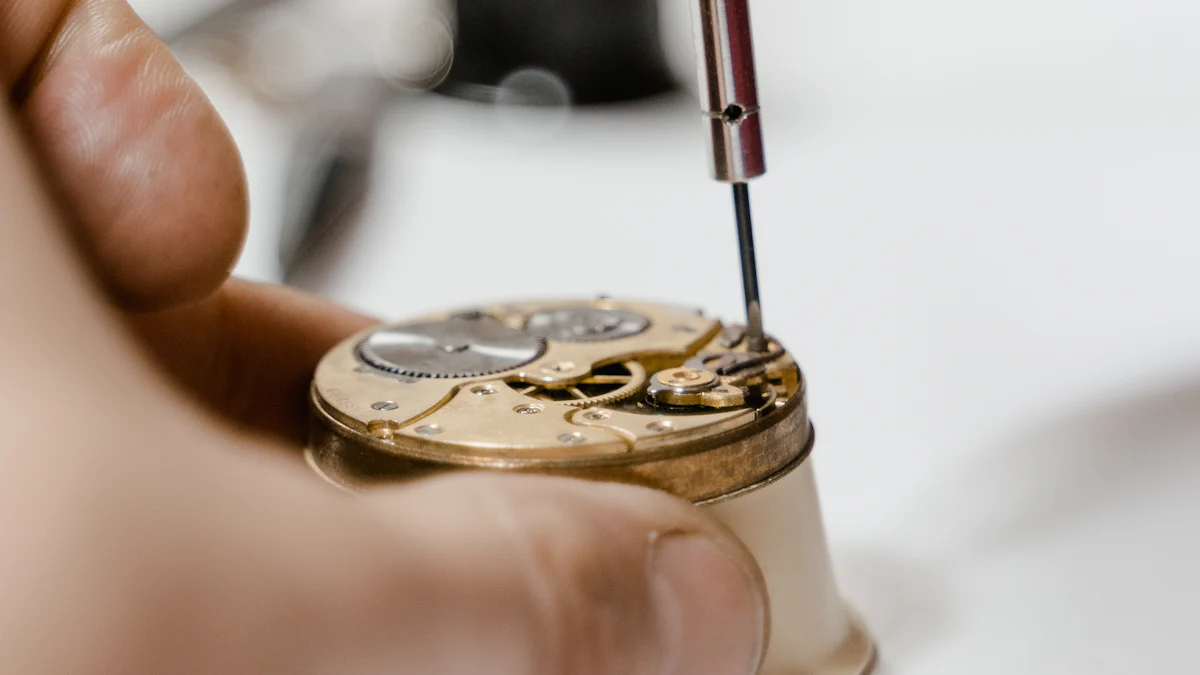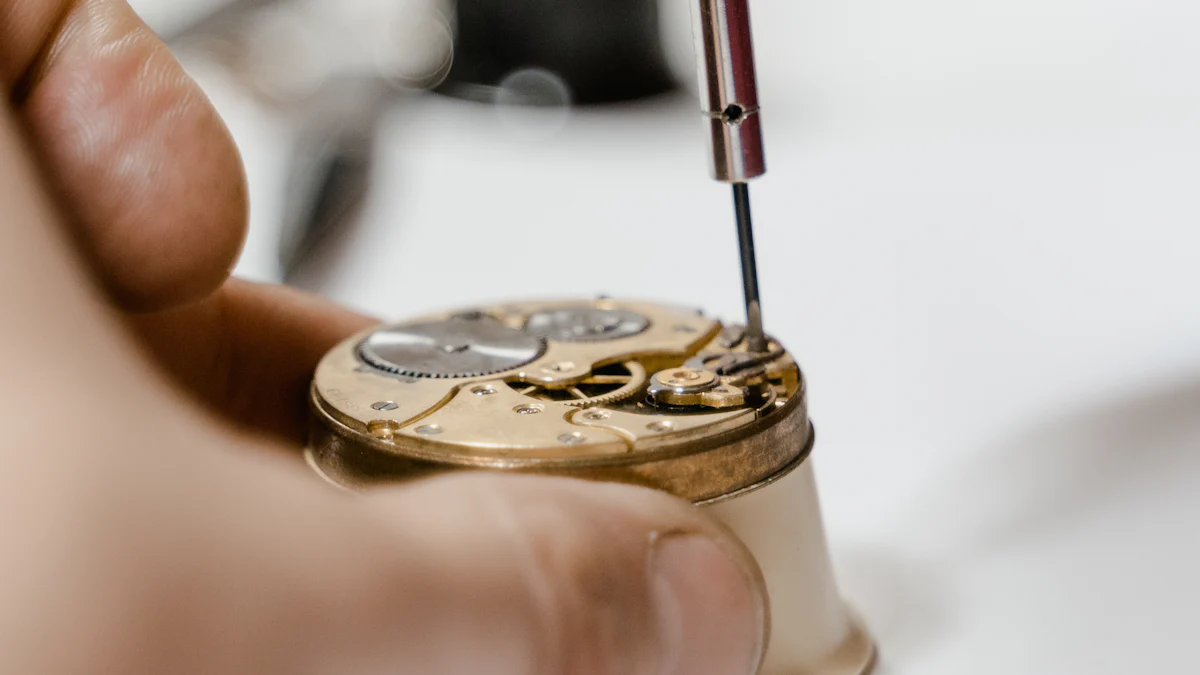
Mastering a watch case spanner offers immense value. You gain the ability to maintain your timepieces with precision. A watch case spanner plays a crucial role in watch maintenance. This tool allows you to open and close screw-back cases securely. Selecting the right tools for different watch case backs ensures effective results. Each watch model may require a specific spanner type. Proper tool selection prevents damage and enhances efficiency.
Understanding Watch Case Backs
Types of Watch Case Backs
Screw-Down Case Backs
Screw-down case backs provide a secure seal for watches. These backs use threads to lock into place. Waterproof watches often feature screw-down backs. A watch case spanner is essential for opening these cases. Proper alignment ensures easy removal and reattachment.
Snap-On Case Backs
Snap-on case backs offer a simple design. These backs rely on pressure to stay closed. You can remove snap-on backs with a case knife or similar tool. Careful prying prevents damage to the watch. Snap-on backs suit non-waterproof watches well.
Swivel Case Backs
Swivel case backs use a rotating mechanism. These backs allow easy access to the watch’s interior. A gentle twist opens swivel backs. Swivel designs often include decorative elements. These backs provide a unique aesthetic appeal.
Identifying Your Watch Case Back Type
Visual Inspection
Visual inspection helps identify the case back type. Look for grooves or notches on the back. Threads indicate a screw-down case back. Smooth edges suggest a snap-on back. A visible hinge points to a swivel back.
Manufacturer’s Guide
The manufacturer’s guide provides valuable information. Check the watch manual for details. The guide specifies the case back type. Follow the instructions for safe opening. Manufacturer recommendations ensure proper tool use.
Tools Required for Using a Watch Case Spanner

To master the use of a watch case spanner, you need specific tools. These tools ensure precision and prevent damage to your watch. Proper equipment makes the process efficient and straightforward.
Essential Tools
Watch Case Spanner
A watch case spanner is the primary tool for opening screw-back cases. This tool fits into the grooves on the back of the watch. You can adjust the spanner to match the size of the case back. A good spanner provides a firm grip and reduces the risk of slipping.
Case Holder
A case holder stabilizes the watch during the opening process. This tool prevents movement and allows you to apply pressure evenly. The holder keeps the watch secure, which minimizes the chance of scratches. You can find adjustable holders that fit various watch sizes.
Tweezers and Screwdrivers
Tweezers and screwdrivers assist in handling small components. These tools help remove screws and other parts from the watch. Precision tweezers allow you to pick up tiny pieces without causing damage. Screwdrivers with different head sizes fit various screws in the watch.
Optional Tools
Loupe or Magnifying Glass
A loupe or magnifying glass enhances visibility. These tools help you see small details on the watch case. Improved visibility aids in aligning the watch case spanner correctly. You can choose a magnification level that suits your needs.
Cleaning Cloth
A cleaning cloth keeps the watch and tools free from dust and fingerprints. Use a soft cloth to wipe the watch case before and after opening. Clean tools ensure better performance and reduce the risk of contamination. Regular cleaning maintains the longevity of your watch case spanner.
Step-by-Step Guide to Using a Watch Case Spanner

Preparing Your Workspace
Ensuring a Clean and Well-Lit Area
Create a clean and well-lit workspace for using a watch case spanner. A tidy area prevents dust from entering the watch. Bright lighting helps you see small details clearly. Ensure that your workspace is free from clutter. A clean environment reduces the risk of damaging the watch.
Organizing Your Tools
Arrange all necessary tools before starting. Place the watch case spanner, case holder, tweezers, and screwdrivers within reach. A loupe or magnifying glass should be nearby for better visibility. Keep a cleaning cloth handy to wipe the watch and tools. Organized tools make the process smooth and efficient.
Opening the Watch Case
Positioning the Watch
Secure the watch in a case holder. The holder stabilizes the watch during the process. Ensure the watch face is up and the case back is accessible. Proper positioning prevents movement and potential scratches. A stable watch allows for precise use of the watch case spanner.
Adjusting the Watch Case Spanner
Select the correct size for the watch case spanner. Adjust the spanner to fit the grooves on the case back. A snug fit ensures a firm grip and reduces slipping. Hold the spanner between your thumb and first finger. Proper adjustment is crucial for effective operation.
Applying the Correct Pressure
Apply firm pressure with the watch case spanner. Turn the spanner counter-clockwise to open the case. Use your other hand to hold the watch firmly. If the case back is tight, use slip-joint pliers for extra grip. Consistent pressure ensures a smooth opening without damage.
Closing the Watch Case
Aligning the Case Back
Align the case back with the watch body. Ensure the threads or notches match correctly. Proper alignment prevents cross-threading or misplacement. Check the manufacturer’s guide for specific instructions. Correct alignment is essential for a secure closure.
Securing the Case Back
Use the watch case spanner to tighten the case back. Turn the spanner clockwise to secure it in place. Apply even pressure to avoid overtightening. A properly secured case back maintains the watch’s integrity. Regular practice enhances skill and confidence in using a watch case spanner.
Troubleshooting Common Issues
Difficulty in Opening the Case
Tips for Stubborn Case Backs
Some watch cases can be challenging to open. A tight screw-back case may resist initial attempts. Persistence and technique are key. Start by inspecting the notches on the case back. Align the spanner wrench tips with these notches. Apply gentle but firm pressure. Use a clockwise motion to loosen the case back. Stabilize the watch in a holder to prevent movement.
If the case remains stubborn, consider using slip-joint pliers for extra grip. Ensure the pliers do not scratch the watch. Patience and finesse will yield success. Avoid forcing the case open. Forcing can damage the watch or the tool. If difficulties persist, seek professional assistance. A skilled watchmaker can offer expertise.
Avoiding Damage to the Watch
Precautions to Take
Preventing damage to the watch is crucial. Always handle the watch with care. Use a clean and well-lit workspace. Dust and debris can harm the watch’s delicate mechanisms. Keep tools organized and within reach. Proper tool use minimizes the risk of scratches.
When opening the case, avoid excessive force. Excessive force can lead to scratches or misalignment. Protect the watch with masking tape if necessary. Masking tape acts as a buffer against accidental slips. Ensure the watch case back does not remain open for long. An open case invites dust and contaminants inside.
After completing maintenance, double-check the watch’s integrity. Verify that the case back is securely closed. A secure closure maintains the watch’s water resistance. Regular practice enhances skill and confidence. Mastery of these techniques ensures the longevity of your timepiece.
Mastering a watch case spanner holds great importance. This skill allows you to maintain watches with precision. Practice regularly to build confidence in using the tool. Consistent use enhances your ability to handle different watch models. Maintain tools by cleaning them after each use. Proper maintenance ensures longevity and reliability. Keep watches free from dust and scratches. Use a soft cloth for regular cleaning. A well-maintained watch retains its value and functionality. Embrace the journey of mastering this essential skill.
